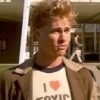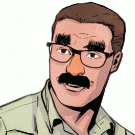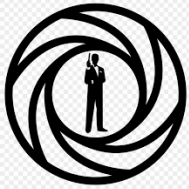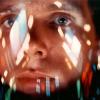Leaderboard
Popular Content
Showing content with the highest reputation on 05/10/20 in all areas
-
5 pointsI couldn't help but join the conversation on this one. Here we go... I think others have done pretty good work on the fictional cosmology here. Cool World and our world are part of a multiverse with different levels of chaos/malleability. Our world is pretty solid, while CW is much looser and more easily influenced by visitors (hence the power of ink). Sometimes people from this world can cross over into other worlds in moments of extreme emotion. Mostly they write it off as dreams or visions. Harris visited in a moment of trauma and just flat-out stayed (I'll get back to that in a second), while Jack visited in reaction to his own self-inflicted trauma and turned it into a successful comic book from prison. The stuff with Doc Whiskers and the Spike are pretty well explained elsewhere in this forum. So I'll jump to theme. The movie Cool World is about dangerous imagination. Harris is unique in that he displays practically no imagination. He's Officer Friday crossed with Spock. His retreat into Cool World makes him an anomaly there, a force of rational order in a world of chaotic imagination. So of course he becomes a cop - it's a metaphorical way (which is how CW operates, really) to reconcile his presence there. Harris is also kind of the early 20th century response to dangerous imagination - keep it under wraps and regulated and absolutely NO SEX (think the Hays Code or the CCA). That brings us to Jack. He taps directly into messy, chaotic CW and instead of trying to control it, he turns it loose in the form of a prison comic. He's kind of a stand-in for Bakshi and Crumb and those underground comix guys that shrugged at codes and rules and went wherever their imagination took them, usually into a more extreme place like CW. Holli places in as the seductive and destructive lure of that world, and if we stick with this logic, removing the Spike shows what happens when that lack of intention with regards to creation gets out of control. It is shown to be ultimately unfulfilling and potentially destructive. In the end, while Jack does replace the Spike, he's consumed by his own id (becoming animated and stuck with Holli). Harris on the other hand, through his resurrection as a doodle, embraces his own imagination. So thematically, Cool World wants us to know that we can't deny our creative impulses, but we shouldn't give into them either. Of course, it's also a terrible movie that was put through a blender by the Hollywood system. I can't necessarily say that any of this really works, but it was fun to think about while listening to the episode. Thanks for that, guys.
-
5 pointsJune couldn’t get over the fact that neither Brad Pitt nor his mom were wearing a helmet while riding the motorcycle, but I was more disturbed by the fact that he took his mom joy riding without letting her turn off the stove. I have to assume that their house was already ablaze by the time the drunk couple crashed into them. Maybe that is why he was ok with staying in Cool World.
-
4 pointsOkay I had a look through my notes and I think I can expand on the work @muttnik has already done to flesh this out a bit more. There are a few scenes in the movie that have key lines of dialogue about Cool World and it's relation to the Noid world. First, yes Cool World is in some other dimension or reality that exist parallel to ours. Doc Whisker invented the Spike with hopes of crossing over into Noid world. However, his first experiment brought Brad Pitt through. Upon seeing him Doc says two key things. First, Brad Pitt is the first body from Noid world to come through implying that people can come via their unconscious or vice versa. Later Deeds night club appearance is called a "mind slip" implying that these short visits might not be all uncommon but no one has permanently stayed. Second, Doc states that Brad Pitt is the first body to come through in his life time. We have no idea how old they are or how they age, but later it is stated the oldest rule in Cool World is "Noids do not have sex with Doodles." Could be that sometime before Doc's work somebody mind slipped into Cool World and had sex with a doodle which cause both of them to alternate between doodle and noid to the point of their death. This also explains why at the end Nails and Brad Pitt's girlfriend know that if a Noid dies in Cool World they become a Doodle. Likely this was also long before Doc's time, but as Noids weren't really part of their life so one paid it heed accept Doc who states that inter-dimension travel to the Noid world has been an obsession of his. Now Brad Pitt does state that he's never had to enforce the no sex law but that's not because other Noids haven't visited. In fact shortly after saying that he tells Deeds that Holli has tried to sleep with him and "every other Noid that has come through here." Most likely there have been mind slips with other people in the time since Brad Pitt had been there but nobody has permanently crossed over. At some point after Brad Pitt's crossing Doc Whiskers crossed over and took his spike with him. However given Brad Pitt's car and their access to Marilyn Monroe films we could speculate that he went back and forth bringing things or attempting to bring things over possibly as tests. Doc Whisker's crossing into Noid world did permanent damage to the link between worlds and he had to create someplace to house the spike to keep the worlds apart. This is why he created the casino and why he never went back. The spike maybe what caused others to mind slip into Cool World. It was during a mind slip that Deeds saw Cool World and it inspired his comic. Due to the fact he gets the characters name wrong (he calls the bouncer Chico to which the bouncer replies 'aint no Chico here') these were merely visions he had and never actually spent time there. Sometime later Holli, influenced by the human things she saw, like Pinocchio wanted to be a real and live in the Noid world. However, because no Doodle and Noid had sex in years she was unaware of the impermanent nature of the transformation and sought the spike as a means to heal herself unaware of it's true function of keeping the worlds apart. How the neighbour and wife murder and other plot points fit in your guess is as good as mine.
-
3 pointsHonestly, while the entire movie is pretty crazy, the wildest moment for me was after Holli kills Harris and then makes the decision to continue her journey to the roof by climbing up from balcony to balcony. You have killed literally the only person actively trying to stop you. Take the freaking stairs, Holli.
-
3 pointsI think teen(?) neighbor was just a fan of Deebs' work and stoked that he was living/lived next door. Her taking any excuse to go over and see him/hang out with him was pretty on-brand for being a teenage girl and meeting someone you admire. The mom was just being a good parent and humoring her in going over there when Deebs and Holli return from Cool World, then probably gave her daughter an earful when they got home about hanging around weirdos. Can relate from personal experience.
-
3 points
-
3 pointsAs the gang and others have already stated, I really had a hard time understanding what was actually happening in the movie. Like, I got the broad strokes of it all, but when it came down to the details, motivations and plot points would seemingly change on a whim--which is truly bizarre in an animated movie. For instance, when Doc Whiskers and Holli meet in Las Vegas, she tells him she wants it so that she can be real. He responds by saying that getting the Spike is impossible, because when *he* tried (because I guess he was trying to become human too?) it almost killed him. But in the very next scene, he tells Deebs and Harris that if she removes the spike it will destroy both universes. So...which is it? Does removing the Spike turn you human or does it destroy the multiverse? And if Doc Whiskers knew that removing it would destroy both universes, why did he even attempt to remove it? I feel like his character is far more insidious than we are led to believe. Of course none of this really matters as the result of removing the Spike turns out to be a completely different scenario in which no one turns human neither universe is destroyed but rather combined.
-
3 pointsThe gang all had different interpretations regarding why Holli and Deebs reverted to the doodles they did at the end of the movie. In particular, they wondered why Holli didn't just revert back to her original design. My interpretation of it was that a Noid turning Doodle will become a caricature of their inner self. When it first occurs to Deebs, he becomes a kind of a cartoonish bum. As for Holli, as she insists on drawing attention to herself in increasingly ridiculous ways, her new Doodle form becomes a kind of bizarre clown monster. She doesn't become Holli as she was, because, as a Noid, that is no longer a reflection of who she is. This is also why when Deebs achieves self-actualization and give up his selfish ways in order to stop Holli, he goes from being a trash bag doodle to a superhero .
-
2 pointsI like your version of things better. There is serious thought and metaphor put into it. I watched the movie and knew that they didn't put either of those things into it so I went by what dialogue I could find.
-
2 points
-
2 pointsI have no idea how I keep making my replies so janky. I don't know what it says about me that (I think?) I understand this messy movie. So Cool World is an alternate dimension, Deebs didn't create any of it. They make mention a few times that Cool World has always existed and that humans have passed through it very briefly. We also see that at least one film from our universe has made it into Cool World. My assumption is that this happens after Doc Whiskers opens the dimensional portal into our 1940s and sucks Harris in. The rift between dimensions is now tenuous and certain individuals- the movie doesn't explain but let's just say through dreams or comas or mental breaks or some unknown set of circumstances- can pass briefly between worlds. This is how Deebs is entering Cool World prior to his introduction in the movie. He thinks he's just dreaming up a fantasy world and makes a comic series off of it. Doc Whiskers probably had the sense that beings from each universe cannot come together because it would start the destruction of one or both worlds. Time travel stories all have that rule about not interacting with past or future versions of yourself, I'm not sure if that rule applies to multi-verse stories as well, I don't really read those. At some point after settling Harris into Cool World, Doc Whiskers enters our world as he previously had planned and takes the spike with him. Holli wants to enter the world she's seeing in the film(s) and though Noids; she has all Cool World has to offer and now wants what she can't have. I think she and Deebs start doodling out because they've broken the laws of physics in our universe and can't sustain form. But I'll give you this one; I have no idea if Harris knew he could come back to life as a doodle after being killed by a doodle. That's the only part that doesn't make sense.
-
2 pointsHi Paul and company. I've been listening to HDTGM since the beginning. (You're one of the first podcasts I downloaded.) I was shocked by your announcement to cover Cool World because this film is particularly traumatic to me. Let me explain. I was in elementary school when this film was released and I saw the previews many times and developed some interest in watching it, probably simply because I had been exposed to it repeatedly. I don't recall ever noticing it in theaters, but maybe half a year later I found it in my local video store and rented it. (My parents didn't notice or care what the film was about.) There have been several delicately bad films from my youth that you have reviewed - such as Masters of the Universe and Streets of Fire, which I LOVED as a kid, and to this day I still rationalize their flaws because they were so magical and intense to me as a child filled with the wonder of the silver screen. But when I watched Cool World on VHS, my heart died. It was the first film I watched that was incomprehensibly bad and nonsensical that I was confused, and then relieved when the film was over. Yet it left me with the horrible realization and knowledge that films could be so awful I couldn't understand how bad they were. I know now that children don't have the finest tastes in the arts, but Cool World destroyed my youthful innocence of taking for granted that films would entertain me in a sensible way and taught me that the world of adults was a scary, dark place of nightmares. I don't think I'll ever forget the fall into Cool World with the weird buildings and scary mouth and the gangster baby who pisses on his chasers to escape them. Coincidentally, about three movies ago I decided to rent the DVD of Cool World from my local Tsutaya video store to give it another chance and was sadly disappointed to realize the movie was even worse than I remembered as a child! This is a minor point, but I was surprised that you all didn't mention that the special effects shots of merging the human actors with the cartoons is very low quality, even though Who Framed Roger Rabbit? blended live action and animation much better a few years earlier. (I guess there were too many horrific things already to discuss in the episode.) The quality of Cool World's process seems to be on par with the poor chemical blending technique used in Jean Claude Van Damme's Double Impact.
-
1 pointI'm mostly in agreement with Amy on this one. For one thing, I would definitely choose Taxi Driver and Raging Bull over this, and I'm okay with that amount of representation from Scorsese/De Niro on the list. (I'd be willing to consider a Scorsese/DiCaprio if people could agree on one, since DiCaprio is really Scorsese's better version of Ray Liotta. Just not Wolf of Wall Street, please.) I think Amy is spot-on about the age thing. I don't remember her mentioning this in the episode of the Canon about Goodfellas, but it's something that I didn't pinpoint as a cause of my frustration until she mentioned it. The real life Billy Batts was 29 years older than the real life Tommy, who was 19 or 20 when he murdered Batts. Frank Vincent, who played Batts in the film, is less than 6 years older than Joe Pesci. That discrepancy completely changes the tone of the scene. From the point of view of Batts, it would seem more like more like a harmless joke for him to tease a teenager. Instead, it looks like they are generational peers, so Batts's teasing comes off as making fun solely of Tommy's social position in the gang, which makes Batts seem more like an asshole, which makes Tommy's response seem, while still excessive, more justified. The other side of this coin is when Tommy terrorizes Spider. In reality, Tommy wouldn't be much older than Spider, so the only difference between them is the social power. Instead, Tommy maybe seems a bit more justified in expecting respect from Spider because of their on-screen age generation difference. In all, it lessens who Tommy is as a character, because we don't get to see how psychopathic he is at such a young age. I love Joe Pesci's performance, and he crafts an incredible character for this, but the character doesn't fit the script as tightly as it could, and that's because he's playing someone 25 years younger. I'd love to say, imagine if Michael Imperioli (who played Spider) were playing Tommy and gave that same performance, how much different the character would seem. But then if Michael Imperioli (or any other 20-25 year old) could give a Joe Pesci performance, I'm sure they would. On the "final day as a gangster" sequence: I'm mostly with Amy, but the pasta sauce argument is not a hill I'm willing to die on. However, she's right that we don't get any indication from the rest of the film that bringing his brother to his house and painstakingly cooking him his favorite meal is in character for Henry Hill. Now, there are two counters to Amy's argument: the "drugs defense", which is that Henry was high out of his mind and we can't expect him to act logically in character under those circumstances; and the "ordinary day defense", which is that these are unremarkable things that tended to happen offscreen and wouldn't need to be noted on except that they happen to be the things that were happening on the day he got busted. (Note that I don't believe that you can argue both of these simultaneously with logical consistency, because either these actions are in Henry's nature, or they aren't.) I have some problems with both of these defenses though. The obvious hole in the "ordinary day defense" is that I think the film goes out of its way to point out how extraordinary the day is, when Henry listed off how busy he was. As far as I can tell, the film is telling us that running all over town to coordinate different things is not something that Henry tended to do on a semi-regular basis. So, the "drugs defense": as far as I can tell, this was Scorsese's intention, as it seems in line with the film's verdict that doing drugs is worse than violence or theft, and it makes the most sense within the story. However, I think this puts a harsh spotlight on the narration. Who is narrating the film? Is it supposed to be Henry's inner monologue at the time depicted on screen? Not likely, because he's using the past tense. Is it supposed to be Henry on the witness stand, which fits with the awkward fourth wall break scene at the end? For one thing, as mentioned in the podcast, that doesn't explain the bits of Karen's narration, since the scene with the FBI guy makes it pretty clear that he doesn't need her to testify. And for another thing, I think that works against the "drugs defense", since if he's stone cold sober on the witness stand making the narration commenting on things he did while high, would he really act as if they all made sense in hindsight? To me, the "drugs defense" only works if you assume the Henry making the narration is also on drugs. So to me, this is far less an indictment of the "drugs defense" than it is of the narration. What I'm trying to say is that the narration in this film sucks, in so many ways. In general, I do find it rare when a film has narration that I actually think is done well, but this is not one of those rare cases. And to be clear, I don't think that Scorsese fell short of his aim in some way. As alluded to on the podcast, Scorsese knows that this film is chock full of shitty, lazy, hack screenwriting and stylistic choices, but included them anyway as a "punk-rock" fuck-you sort of spirit. He is enough of a technical master and a student of cinema that he knows full well how incoherent so much of this is, which he did to make the film intentionally jarring to audiences. He executed that vision exceptionally. I'm just far less impressed by that vision as I am of so much of his other work. I'm still glad this film exists! It's fun to watch, and like Amy, I'm happy that so many people love it more than me. I just think it's a bit overrated among Scorsese's filmography, and I wouldn't vote for it on the AFI list. And finally, I just want to say that I used to think the "Layla" sequence was one of the best melds of music and film. On this rewatch, it's really not. "Layla" just happens to be one of the greatest songs ever written, so of course it heightens anything it's used for. I could make a montage of myself taking out the garbage and it would be more captivating and memorable if I put "Layla" overtop of it. In general, I had a particularly negative reaction to all of the music drops on this rewatch. Also, lots of people making their first posts on the forum for this film. Which is great! I'm always curious which films/episodes of the podcast will cause people to create an account, but it's not too surprising that this is one of them. I hope everyone comes back in a couple weeks to talk about The Bridge on the River Kwai as we all get the Colonel Bogey March stuck in our heads.
-
1 pointThe issue of how long Gabriel Byrne was in prison was brought up in the episode. I just watched the film’s original trailer and it states that he has been in prison for 10 years, which seems too short of a sentence for murder and too long to be away for his neighbor to have that kind of an attachment to him. And are we to believe that his house was just sitting empty for a decade? Also the trailer suggests that he began creating the comic while in prison. I find it hard to believe that a convict’s comic book would become as popular as Cool World supposedly is. I mean how did he get comic book stores to carry it in the first place? And if they are all being made from prison, then aren’t they all technically signed by him from behind bars? Why does the comic book shop make that signed copy such a rare a valuable piece of memorabilia?
-
1 pointOn Paul's thought that the casino/gambling hall in the open could have been Vegas's first, it just might be? There were illegal gambling halls all over Nevada decades prior, but if where it's located in the 40s is supposed to have some correlation to Deeb's house in the 90s, I think the building could have been the Northern Club, which was the first to receive a gaming license. It's fudging things by a few blocks though, and that may be giving this movie way too much credit. They probably just had Harris materialize in the last place Deebs/the multi-verse rift was/the easiest set to film in.
-
1 pointI read a long time ago that after Bakshi saw what the studio was doing to the movie, he told the animators to just draw whatever they thought was funny.
-
1 point
-
1 pointSo there are many issues with the comic book store. First, unlike Tall John said there are other comics in the shop it's not just Cool World. We see some Batman and Superman wall books, a couple Akira comics, and in Jack's stack of things he was buying we can see an issue of New Gods and Teen Titans. The fact that DC did a prequel comic is starting to make a bit more sense. Second, all the Cool World books are behind the register. They're like nudie magazines at a convenience store or something in which you have to ask the clerk for them. How are people suppose to look through them? Is Cool World for adults only? Third, they are selling a very rare signed from prison issue of Cool World. What would indicate if a comic was signed in or not in prison? It's issue number 3 so clearly it was published before his time in prison. What's to stop some schmuck from folding an autographed issue they already had in half and claiming it was from prison? That's another thing. The comic is folded in half with a very hard crease. That's got to bring the comic down a ton in value even if it was autographed from prison. Lastly and this is more of an Easter Egg than a nonsensical thing, but the rather larger gentleman in the comic shop is seen reading an issue of Animation Magazine. Not only that but it's an issue with Ralph Bakshi (Cool World's director) on the cover of it.
-
1 pointWell clearly there are police because we have that whole chase scene so I want to know is if Brad Pitt is working with them. If so he managed to become a detective it seems so that means he had to work his way up through the ranks. At one point was Brad Pitt riding around in that police car with a bunch of tiny guys? Did he have a beat that he walked? I want to know.
-
1 pointThe most improbable thing in this movie was not the existence of an alternate dimension cartoon world but that Jack Deebs channeling his vision of it into a comic book would be a huge hit. I was curious if anyone had theorized what the content of those books would be and found that DC published a 4 issue Cool World prequel comic to go along with the release of the movie. The first issue can be bought online right now for $2.60. It retailed for $1.75 at the time so its value hasn't quite kept up with inflation. They have also been posted online. http://vlcomic.com/read/comic-cool-world-eng/1 I read the first issue and here are some highlights if you don't want to waste your 10 minutes. Harris is a petty criminal in the first issue not a detective. Almost every object in the comic is anthropomorphized. Cool World is one of (many?) cartoon worlds it is right next to Sweet Place. Holli tries to seduce Harris to get to the real world but he won't break that rule even though he is a criminal. Another human enters Cool World while he is dreaming so presumably other than Harris and Deebs that is how Noids get to the cartoon dimension.
-
1 pointI agree with this. The movie looks significantly cheaper than Roger Rabbit despite coming out a few years later. The budget on this was $50 million but Roger Rabbit was $70 million. I don't know anything about animation costs, but is a $20 million difference enough for this to look that much worse? I think the animation in this occasionally looks good but it really looks significantly cheaper than Roger Rabbit. I read an interview with Bakshi and he admits some fault in the fact that he's maybe not the best guy to be running a production this large. So, maybe that's part of it?
-
1 pointI think one of the major points glossed over was upending the "noble Mafia criminal" trope that the Godfather films spawned. When I saw the movie my first thought afterwards was that I loved how it subverted the HUGE cultural Godfather Mafia myth. The film basically tears down all the noble, family first, "we're not animals, we're businessmen, our families are important" theme of both Godfather movies. They are venal, fairly dumb, violent thugs and not criminal masterminds looking to create an Empire. They are making jokes, robbing, getting loot - but then murdering someone because they get irked for 2 seconds, destroying their own efforts.
-
1 pointIf there is only one law in Cool World and no one has ever broken it, why do they even have Brad Pitt as a police officer? Why is there even a police department?
-
1 pointAnd the other characters in the movie literally tell this to him. Both Paulie and Jimmy tell him he needs to lay off the drugs because they're turning his "mind into mush." This whole sequence demonstrates that. Within this sequence we also have a direct refutation of the idea that Henry's narration only repeats to us what's on the screen: the guns he brings to Jimmy are clearly crap, as we can see from the visuals. Jimmy is right to reject them. Yet Henry's narration acts like Jimmy was crazy to turn them down. He's not reliable, and the movie wants you to know that. The narration puts you at a distance on purpose.
-
1 pointAmy you have completely misread the last 30 minutes of Goodfellas. The prominence of the making of the food and the brother in the 3rd act has absolutely nothing to with Henry Hills relationship to them. It is merely meant to show his state of mind. That it is jarring to the audience is precisely the point. The film isn't trying to say he goes out of his way to pick up his brother and make him his favorite meal amid all the craziness because of some great love or loyalty. He's out of his mind on drugs, he shouldn't even leave the house. The fact that stirring sauce and trafficking guns and drugs is given the same weight by the narrator is insane and that's the point!! He has lost the ability to tell the difference between the mundane and ultra serious parts of the story he is telling. These things had only been shown in background up until now because they were incidental to the story. They still are but he's so off the rails there is no difference in his mind. This is exactly the way that someone that coked out would tell it. It's actually brilliant.
This leaderboard is set to Los Angeles/GMT-08:00
-
Newsletter













